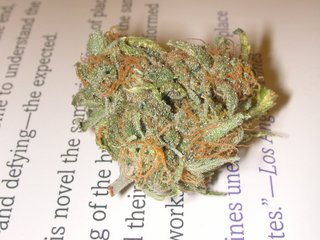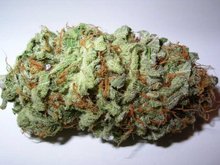Marijuana
The cannabis plant can be dried or otherwise processed to yield products containing large concentrations of compounds that have psychoactive and medicinal effects when consumed, usually by smoking or eating. Cannabis (also called marijuana, or pot in slang) has been used for medical and psychoactive effects for thousands of years. Throughout the 20th century there was a massive upswing in the use of cannabis as a psychoactive substance, mostly for recreational purposes but to some extent for religious purposes. more...
The possession, use, or sale of psychoactive cannabis products became illegal in many parts of the world during the early 20th century, and remains that way today.
History
Cannabis has been known as a medicinal and psychoactive compound from very early in history, and has been used continuously throughout the world, typically without stigma until the mid-20th century, when, mainly under the leadership of newspaper baron William Randolph Hearst and the United States, prohibition became increasingly global.
Ancient history
Cannabis was known across the ancient world, including ancient Israel. The Hebrew Bible mentions cannabis in Exodus 30:23, in a list of 'drugs' (שָׂמִים śāmîm) that are processed into an aromatic holy oil to anoint the Ark of the Covenant and the Tabernacle (and thus God's Temple in Jerusalem).
In Biblical Hebrew, the term for cannabis is qěnēh bośem and literally means 'reed of balm' to refer to the aromatic resin that the cannabis plant exudes. Ultimately the English term cannabis derives from the Hebrew term qěnēh bośem. Hebrew קְנֵה בֹּשֶׂם qěnēh bośem abbreviated into קַנַּבּוֹס qannabbôs which entered Greek as κανναβις kannabis and then Latin as cannabis . The abbreviated form qannabbos is attested in Post Biblical Hebrew.
English versions of the Hebrew Bible tend to mistranslate the Hebrew term qěnēh bosem as 'calamus' because of the Greek Septuagint. The Septuagint misunderstood the Hebrew term to mean some unidentified 'reed of balm' and thus misconstrued it as a reference to the 'balmy' (scented) calamus reed, or καλαμος kalamos in Greek. Calamus was known in Greek mythology and was processed into an aphrodisiac. Even so, the Hebrew term originally refers to cannabis.
Cannabis was also known to the Scythians, as well as to the Thracians/Dacians (ancestors of present day Eastern-Europeans), whose shamans (the kapnobatai - "those who walk on smoke/clouds") used to burn cannabis flowers in order to induce trances. The cult of Dionysus, which is believed to have originated in Thrace, has also been linked to the effects of cannabis smoke.
The most famous users of cannabis though were the ancient Hindus. It was called 'ganjika' in Sanskrit ('ganja' in modern Indian languages). According to legend, Shiva, the destructive aspect of the Hindu trinity, told his disciples to use the hemp plant in all ways possible. The ancient drug soma, mentioned in the Vedas as a sacred intoxicating hallucinogen, was sometimes identified with cannabis. However it has also been identified with a number of plants and a mushroom Amanita muscaria.
Read more at Wikipedia.org



